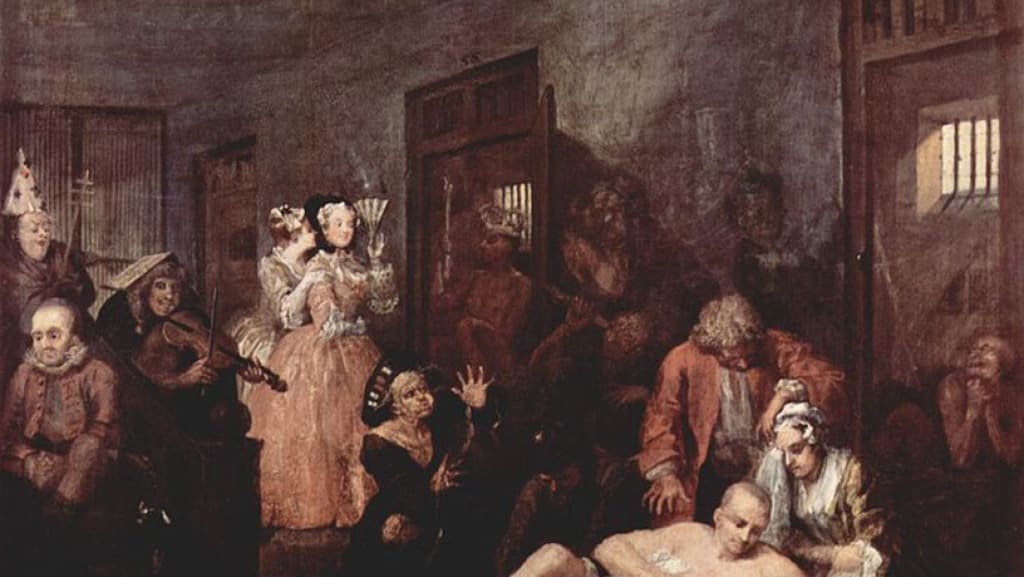
Our historical efforts to understand abnormal psychology include both humor and tragedy. I will briefly discuss some highlights of psychopathology and some exciting and absurd treatments that were used to cure peoples minds. How from beliefs and superstitions we came to scientific awareness and explanations to natural causes.
Demonology, Gods, and Magic:
Chinese, Egyptians, Hebrews, and Greeks were considered as the first ones to attribute abnormal behavior to a demon or god who has taken control over their soul. If a "possessed" person had impaired speech, saying words from the bible or had mystical or religious significance, it was usually considered that a good spirit possessed he or her. People like that were treated well, and they were supposed to have supernatural powers.
Unfortunately other types of "possession," particularly when people were overly excited or overreacting in behavior contrary to religious teaching, it was considered they are being taken over by evil spirits. There was also a possibility that a person with such behavior might have been taken over by an angry god. Moses is quoted the Bible saying "The Lord Shall smite thee with madness."
The mainly used type of treatment was the exorcism. It usually included magic, prayer, incantation, noise making and use of terrible-tasting drink made from sheep's dung and wine.
Philosophical Conceptions (Plato):
We all know Plato and his numerous amount of work when it comes to psychology and the human body. He was also one of the first ones to study mentally disturbed individuals who have committed criminal actions and how to deal with them. He was trying his best to emphasize individual differences in intellectual and other abilities that could affect the shaping of thinking and behavior. Plato was the first one with an idea of developing facilities to care for individuals who had problems with development that would affect they antisocial behavior. They would be put in conversation with people that we know call (psychologists) to promote the health of their soul. Unfortunately, at that moment, his modern idea was not accepted.
Middle Ages:
The first mental hospital was established in Baghdad in 792 A.D. Unfortunately, there were no improvements in healing peoples mind, opposite it got harder. During the Middle Ages supernatural explanation of why people have mental issues was more popular and nobody was interested in scientific reasons. Exorcism and witchcraft was still predominant way of dealing with illnesses and here is a quote of how exactly it was happening and what has been used "For a fiend-sick man: When a devil possesses a man or controls him from within diseases, a spew-drink of lupin, bishopswort, henbane, garlic. Pound these together, add ale and holy water" (Cockayne, 1864-1866).
Sometimes even bad habits or bad qualities in a person were considered witchcraft and mental illness to what Schoeneman in 1984 made a funny comment "the typical accused witch was no a mentally ill person but an impoverished woman with a sharp tongue and a bad temper."
Towards Humanitarian Approaches:
Finally in the very beginning, if Renaissance scientific way of dealing with problems emerged. Of course, at first nobody was cured, the "craziest" patients were living outside the hospitals so that people could watch them for a small fee. Some of the more quiet ones were carried to the city to be observed as well so that hospitals had money for feeding them.
The first hospital that used some methods for curing patients was Pennsylvanian Hospital in Philadelphia in 1756. They used powerful drugs, water treatments, bleeding, electric shocks and physical restraints. But already in 1792 during the French revolution a lot of psychologists have realized that this harsh of procedures are not helping at all, opposite its making everything worse. Dix and her mental hygiene movement made the government invest more into facilities for curing people, spend money into training stuff to be more kind and gentle with people. It was established that way so that hospitalized people would have their mind filled with positive and healthy energy. It was implemented that people with mental illnesses would have plenty of activities and workout every day—healthy body healthy mind.
There is a lot more to the history of this whole idea of mental health. We know how people are being treated now and how we do not implement any new ways of treating people in the wrong way. Opposite, we try our best to improve mental awareness as much as possible, and the understanding of the past of psychopathology will help us not to make the same mistakes.
Reference:
Adams, F. (1939). The genuine works of Hippocrates. Baltimore: Williams and Wilkins.
Brown, P., & van der Hart, O. (1998). Memories of sexual abuse: Janet's critique of Freud, a balanced approach. Psychological Reports, 82, 1027-1043.
Bryant, R. (1997). Folie a familie: A cognitive study of delusional beliefs. Psychiatry, 60, 44-50.
Harrington, A. (1987). Mind, medicine, and the double brain. Princeton, NJ: Princeton University Press.
Libbrecht, K., & Quakelbeen, J. (1995). On the early history of male hysteria and psychic trauma. Charcot's influence on Freudian thought. Journal of History in the Behavioral Sciences, 31, 370-384.
Luckins, A. (1989). The rise and decline of the American asylum movement in the 19th century. Journal of Psychology, 122, 471-486.
MacDonald, M. (1981). Mystical bedlam: Madness, anxiety and healing in 17th century England. Cambridge: Cambridge University Press.
Maher, B., & Maher, W. (1994). Personality and psychopathology: A historical perspective. Journal of Abnormal Psychology, 103, 72-77.
Russell, J. B. (1980). A history of witchcraft: Sorcerers, heretics, and pagans. New York: Thames and Hudson.
Sass, L. A. (1992). Madness and modernism: Insanity in the light of modern art, literature, and thought. Cambridge, MA: Harvard University Press.
Shorter, E. (1996). A history of psychiatry: From the era of the asylum to the age of prozac. New York: Wiley.
Torrey, E., & Wolfe, S. (1986). The case of the seriously mentally ill: A rating of state programs. Washington, DC: Public Citizen Health Research Group.
Wilkins, K. (1974). Attitudes to witchcraft and demonical possession in France during the 18th century. Journal of European Studies, 3, 349-362.
Woodward, W. E. (1969). Record of Salem witchcraft. New York: DaCapo Press.
About the Creator
Di Rocha
*Passionate about Psychology
*Love Reading
*Super Nerdy






Comments
There are no comments for this story
Be the first to respond and start the conversation.